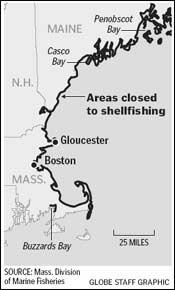Disclaimer: These postings were sent to us from a variety of media sources over the Internet. The content has not been reviewed for scientific accuracy or edited in any manner.
As red tide intensifies, so do Cape's concerns
Businesses fear tourism impact
 |
MacGregor "Mac" Hay of Mac's Seafood in Wellfleet said his restaurant's supply of Wellfleet oysters will be gone tomorrow. (Globe Photo / Julia Cumes) |
By Rebecca Mahoney and Ralph Ranalli, Globe Correspondent and Globe Staff | June 3, 2005
New England's worst red tide outbreak in decades has expanded into the waters south of Cape Cod, forcing the closure of the state's most prolific shellfish bed and jeopardizing the all-important summer season for Cape businesses that depend on tourists seeking local seafood.
Officials shut the fertile flats and waters surrounding the Monomoy Natural Wildlife Refuge off Chatham yesterday, after scientists found dangerous levels of the toxic algae bloom. Fishermen reap a rich harvest of clams, oysters, and other shellfish from the area off the elbow of Cape Cod.
With red tide spreading around the tip of the Cape, officials have also closed shellfish beds near Bourne and Wareham in Buzzards Bay for the first time, after the flats there were tainted by red tide passing through the Cape Cod Canal.
 |
While Nantucket Sound, Vineyard Sound, and parts of Buzzards Bay remain open, shellfish beds from Central Maine to Cape Cod Bay, as well as waters around Chatham and Pleasant Bay, have been shut down in recent weeks by the unusually virulent outbreak of red tide. State officials said nearly 50 percent of Massachusetts's shellfish beds have been closed.
And it's only getting worse. The level of toxins in the water is doubling every few days, and the toxin levels in shellfish in some areas are so high that eating just a few infected clams or mussels could be fatal, said Don Anderson, a red tide specialist at Woods Hole Oceanographic Institution.
Red tide is a natural phenomenon caused by an explosion of single-celled organisms that collect in clams, mussels, and other shellfish. The algae is not harmful to the shellfish, but can cause illness or even death in humans if enough is consumed. It does not affect lobsters, shrimp, crabs, or fish, however, and the shellfish currently being sold in restaurants and stores was harvested in beds that were or still are safe, officials said.
Unlike red tide outbreaks in Southern waters, which create noxious fumes and have previously forced the closure of beaches in Florida, swimmers in the waters off Cape Cod this summer should not be affected by the algae bloom.
While red tide is commonly found in the ocean off Maine and frequently creeps into the waters off the coast of New Hampshire and the North Shore of Massachusetts, it's rare to find it as far south as Cape Cod or at levels this high, said Anderson.
''We're seeing cell concentrations . . . that are basically as much as 10 times higher than what we were seeing even 10 days ago," Anderson said. ''This is certainly the most we've ever seen in [Cape Cod] in 30 years." The outbreak could eventually prove worse than the one in 1972, he said, when the ocean took on a reddish tint.
''If you look at the cell count numbers, they're really high, higher than anybody's ever seen," said J. Michael Hickey, Massachusetts's chief shellfish biologist. ''In terms of toxin numbers, every time we go out, they're going up. They're not going down."
Scientists are unsure how long the bloom will last, but they say it is unlikely shellfish beds will open for at least four weeks. Heavy rains and strong winds this spring are blamed for the outbreak's wide range, carrying toxins from northern Maine into southern Massachusetts.
Officials are also bracing for a second possible outbreak. Scientists said another particularly toxic algae bloom may be headed south from Maine, dealing Massachusetts's fisheries another blow.
''We could introduce a whole new population here," Anderson said. ''We know those cells are up in Maine, and if they do travel to the south, we may see a second bloom even after this one has diminished."
Anderson said it will take favorable winds, warmer temperatures, and a drop in the nutrients the algae feeds on for the red tide to dissipate. Even after toxins dissipate, it still takes a few weeks for shellfish to become safe to eat.
David Gallant, the owner of Southeast Shellfish, a wholesaler in Wareham, said he is worried about the welfare of his 40 employees if the red tide persists.
''The season doesn't look good," he said. ''I'm not sure what we're going to do."
Meanwhile, with the Cape's peak season underway, restaurateurs are scrambling to import enough clams and oysters to satisfy tourists' appetites.
Mac's Seafood, a traditional shrine to shellfish on Wellfleet Pier, was down to its last 400 Wellfleet oysters, the renowned, sweet mollusk yesterday. Co-owner MacGregor ''Mac" Hay predicted there would be 200 or fewer today. By tomorrow they will be gone, he said.
''People who are into shellfish, they want their Wellfleets," Hay said. ''It's a bummer."
Hay said he is stocking Blue Points from Connecticut and Malpeques from Canada, but expects to sell only about a quarter of the 50,000 oysters he does in a typical year through his three locations in Wellfleet and Truro.
This year's intense red tide, he said, has ''put a cloud over the whole seafood-summer-fried-clam-plate thing" on the Cape. It's all anyone can talk about, he said, including the tourists.
''If we were just a clam shack, we'd be in trouble."